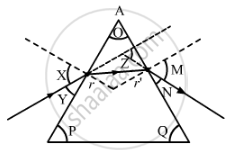Advertisements
Advertisements
Question
When we place a glass prism in the path of a narrow beam of white light a spectrum is obtained. What happens when a second identical prism is placed in an inverted position with respect to the first prism? Draw a labelled ray diagram to illustrate it.
Solution
The first prism disperses white light into its seven constituent colours and forms the spectrum. The other inverted prism recombines all the seven colors and gives a white light.
RELATED QUESTIONS
The path of a ray of light passing through a glass prism is shown below:

In this diagram, the angle of prism, angle of incidence, angle of emergence and angle of deviation, respectively, have been represented by:
(A) O, Y, Z and N,
(B) P, Y, M and Z,
(C) O, X, M and Z,
(D) P, X, Z and N.
As light rays pass from air into a glass prism, are they refracted towards or away from the normal?
The splitting up of white light into seven colours on passing through a glass prism is called:
(a) refraction
(b) deflection
(c) dispersion
(d) scattering
You are given a disc divided into seven sectors with colours violet, indigo, blue, green, yellow, orange and red in them. What would be its colour when it is rotated rapidly?
What conclusion do you draw about the nature of white light in part (b)?
Answer the following:
What do you mean by dispersion? Name the different colours of light in the proper sequence in the spectrum of light.
Match the Columns:
| Column ‘A’ | Column ‘B’ |
| The wavelength of red light | (a) 600 nm |
| (b) 700 nm | |
| (c) 500 nm |
Write an Explanation.
Critical angle
Observe the given figure and write appropriate phenomenon of light in the box.

Which one of the following is involved for the formation of rainbow in the sky?
